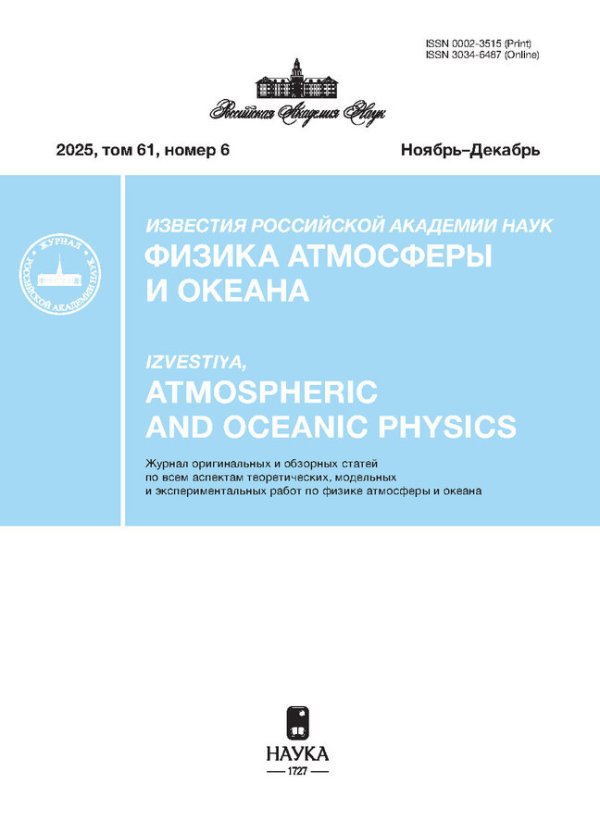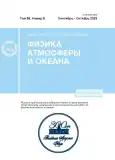Influence of the Weak Surface Film on Formation and Propagation of Wind Waves in a Channel
- Authors: Plaksina Y.Y.1, Pushtaev A.V.1, Vinnichenko N.A.1, Uvarov A.V.1
-
Affiliations:
- Lomonosov Moscow State University, Faculty of Physics
- Issue: Vol 59, No 5 (2023)
- Pages: 661-672
- Section: Articles
- URL: https://journals.rcsi.science/0002-3515/article/view/140372
- DOI: https://doi.org/10.31857/S0002351523050097
- EDN: https://elibrary.ru/PLOWBA
- ID: 140372
Cite item
Full Text
Abstract
Processes of the wind waves formation remain poorly understood, despite the numerous studies. One of the main reasons, in our opinion, is that simplified theoretical analysis does not take into account the weak film of natural contaminants. In the present work waves generation in two channels is experimentally studied and compared for ethanol, water and water with addition of soluble surfactant SDS (sodium dodecyl sulphate) in various concentrations. The employed concentrations hardly affect the surface tension coefficient, but lead to significant modification of the subsurface flow structure. In ethanol the surface film is not formed, so it can be considered as reference case. In water and water with added surfactant the film gets broken and the surface becomes clean at certain critical wind speed, which grows for increasing surfactant concentration. For the surface to remain clean, the contaminant adsorption to the surface must be compensated by its removal by the tangential stress. Three experimental techniques are used to study the influence of cool skin on formation of the wind waves. The surface relief is measured with modified color schlieren technique and the liquid velocity fields are determined with Particle Image Velocimetry (PIV). The surface temperature fields, which allow identification of the regions of the cool skin rupture, are obtained with IR thermography. IR thermography is also used to study the surface velocity field (IR PIV). The film is shown to have significant influence on both the waves amplitude and the structure of subsurface flow.
Keywords
About the authors
Yu. Yu. Plaksina
Lomonosov Moscow State University, Faculty of Physics
Author for correspondence.
Email: yuplaksina@mail.ru
Russia, 119991, Moscow, Leninskiye Gory, 1/2
A. V. Pushtaev
Lomonosov Moscow State University, Faculty of Physics
Email: yuplaksina@mail.ru
Russia, 119991, Moscow, Leninskiye Gory, 1/2
N. A. Vinnichenko
Lomonosov Moscow State University, Faculty of Physics
Email: yuplaksina@mail.ru
Russia, 119991, Moscow, Leninskiye Gory, 1/2
A. V. Uvarov
Lomonosov Moscow State University, Faculty of Physics
Email: yuplaksina@mail.ru
Russia, 119991, Moscow, Leninskiye Gory, 1/2
References
- Голицын Г.С. Статистика и динамика природных процессов и явлений. Методы, инструментарий, результаты. М.: Красанд, 2013. 400 с.
- Дружинин О.А. О динамике дрейфового течения при слабом ветре // Изв. РАН. Физика атмосферы и океана. 2021. Т. 57. № 6. С. 743–752.
- Кандауров А.А., Троицкая Ю.И., Сергеев Д.А., Вдовин М.И., Байдаков Г.А. Среднее поле скорости воздушного потока над поверхностью воды при лабораторном моделировании штормовых и ураганных условий в океане // Изв. РАН. Физика атмосферы и океана. 2014. Т. 50. № 4. С. 455–467.
- Ламб Г. Гидродинамика. М.: ОГИЗ, 1947. 929 с.
- Монин А.С., Яглом А.Я. Статистическая гидромеханика. Ч. 1. М.: Наука, 1965. 640 с.
- Монин А.С., Красицкий В.П. Явления на поверхности океана. М.: Гидрометеоиздат, 1985. 376 с.
- Плаксина Ю.Ю., Пуштаев А.В., Винниченко Н.А., Уваров А.В. Влияние малых примесей на формирование структур при конвекции Рэлея-Бенара-Марангони в плоском слое жидкости. // Вестник Московского университета. Серия 3: Физика, астрономия. 2018. Т. 5. С. 56–62.
- Реутов В.П., Езерский А.Б., Рыбушкина Г.В., Чернов В.В. Конвективные структуры в тонком слое испаряющейся жидкости, обдуваемой воздушным потоком // ПМТФ. 2007. Т. 48. № 4. С. 3–14.
- Федоров К.Н., Гинзбург А.И. Приповерхностный слой океана. Л.: Гидрометеоиздат, 1988. 303 с.
- Черноусько Ю.Л., Шумилов А.В. Испарение и микроконвекция в тонком поверхностном слое // Океанология. 1971. Т. 11. № 6. С. 982–986.
- Banner M.L., Peirson W.L. Tangential stress beneath wind-driven air-water interfaces // J. Fluid Mech. 1998. V. 364. P. 115–145.
- Benetazzo A., Fedele F., Gallego G., Shih P.-C., Yezzi A. Offshore stereo measurements of gravity waves // Coast. Eng. 2012. V. 64. P. 127–138.
- Deskos G., Lee J.C.Y., Draxl C.A., Spraque M.A. Review of wind-wave coupling models for large-eddy simulation of marine atmospheric boundary layer // J. Atmos. Sci. 2021. V. 78. № 10. P. 3025–3045.
- Izzet A., Moerman P.G., Gross P., Groenewold J., Hollingsworth A.D., Bibette J., Izzet J.B. Tunable persistent random walk in swimming droplets // Phys. Rev X. 2020. V. 10. P. 021 035.
- Jähne B., Klinke J., Waas S. Imaging of short ocean wind waves: a critical theoretical review // JOSA A. 1994. V. 11. № 8. P. 2197–2209.
- Katsaros K.B., Liu W.T., Businger J.A., Tilman J.A. Heat transport and thermal structure in the interfacial boundary layer measured in an open tank of water in turbulent free convection // J. Fluid Mech. 1977. V. 82. № 2. P. 311–335.
- Keane R.D., Adrian R.J. (1992) Theory of cross-correlation analysis of PIV images // Appl. Sci. Res. 1992. V. 49. P. 191–215.
- Kosnik M.V., Dulov V.A. Extraction of short wind wave spectra from stereo images of the sea surface // Meas. Sci. Technol. 2011. V. 22. № 1. P. 015504.
- Kou J., Judd K.P., Saylor J.R. The temperature statistics of a surfactant-covered air/water interface during mixed convection heat transfer and evaporation // Int. J. Heat Mass Transfer 2011. V. 54. P. 3394–3405.
- Kudryavtsev V., Shrira V., Dulov V., Malinovsky V. On the Vertical Structure of Wind-Driven Sea Currents // J. Phys. Oceanogr. 2008. V. 38. P. 2121–2144.
- Li T., Shen L. The principal stage in wind-wave generation // J. Fluid Mech. 2022. V. 934. P. A41.
- Longo S., Chiapponi L., Clavero M., Mäkelä T., Liang D. Study of the turbulence in the air-side and water-side boundary layers // Coast. Eng. 2012. V. 69. P. 67–81.
- Miles J.W. On the generation of surface waves by shear flows // J. Fluid Mech. 1957. V. 3. № 2. P. 185–204.
- Moisy F., Rabaud M., Salsac K. A synthetic Schlieren method for the measurement of the topography of a liquid interface // Exp. Fluids. 2009. V. 46. P. 1021–1036.
- Pawliszak P., Ulaganathan V., Bradshaw-Hajek B.H., Manica R., Beattie D.A., Krasowska M. Mobile or immobile? Rise velocity of air bubbles in high-purity water // J. Phys. Chem. C 2019. V. 123. P. 15131–15138.
- Phillips O.M. On the generation of waves by turbulent wind // J. Fluid Mech. 1957. V. 2. № 5. P. 417–444.
- Raffel M., Willert C.E., Scarano F., Kähler C.J., Wereley S.T., Kompenhans J. (2007) Particle image velocimetry: a practical guide. Third edition. Springer: Berlin, 2018. 669 p.
- Rudenko Y.K., Vinnichenko N.A., Plaksina Y.Y., Pushtaev A.V., Uvarov A.V. Horizontal convective flow from a line heat source located at the liquid–gas interface in presence of surface film. // J. Fluid Mech. 2022. V. 944. P. A35.
- Schlussel R., Emery W.J., Grassel H., Mammen N. On the bulk skin temperature difference and its impact on satellite remote sensing of sea surface temperature // J. Geophys. Res. 1990. V. 95. P. 13341–13356.
- Siddiqui K., Loewen M.R. Characteristics of the wind drift layer and microscale breaking waves // J. Fluid Mech. 2007. V. 573. P. 417–456
- Veron F., Melvill W.K. Experiments on the stability and transition of wind-driven water surfaces // J. Fluid Mech. 2001. V. 446. P. 25–65.
- Veron F., Melville W.K., Lenail L. The effects of small-scale turbulence on air–sea heat flux // J. Phys. Oceanogr. 2011. V. 41. № 1. P. 205–220.
- Vinnichenko N.A., Plaksina Yu.Yu., Baranova K.M., Pushtaev A.V., Uvarov A.V. Mobility of free surface in different liquids and its influence on water striders locomotion // Environ. Fluid Mech. 2018. V. 18. P. 1045–1056.
- Vinnichenko N.A., Pushtaev A.V., Plaksina Y.Y., Uvarov A.V. Measurements of liquid surface relief with moon-glade background oriented schlieren technique // Exp. Therm. Fluid Sci. 2020. V. 114. P. 110051.
- Yousefi K, Veron F., Buckley M.P. Turbulent and wave kinetic energy budgets in theairflow over wind-generated surface waves // J. Fluid Mech. 2021. V. 920. A33.
- Zavadsky A., Shemer L. Water waves excited by near-impulsive wind forcing // J. Fluid Mech. 2017. V. 828. P. 459–495.
- Zavadsky A., Benetazzo A., Shemer L. On the two-dimensional structure of short gravity waves in a wind wave tank // Phys. Fluids. 2017. V. 29. 016601.
- Zhang X., Cox C. Measuring the two-dimensional structure of wavy water surface optically: A surface gradient detector // Exp. Fluids 1994. V. 7. P. 225–237.
- Zhang X., Dabiri D., Gharib M. Optical mapping of fluid density interfaces: Concepts and implementations // Rev. Sci. Instrum. 1996. V. 67. № 5. P. 1858–1868.
Supplementary files




















